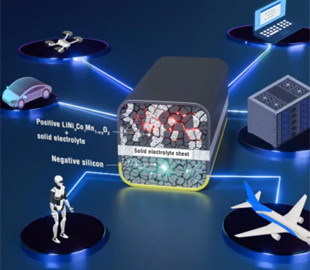
Thanks to the new technology, laptops, drones, electric cars and other equipment will become more productive and safer.
Scientists in Japan have developed a quasi-solid-state lithium-ion battery that provides increased stability, safety and a longer service life. This achievement was reported by SciTechDaily.
Lithium-ion batteries are the primary power source for many gadgets and electric vehicles. These batteries typically use an organic electrolyte solution, which is necessary for high energy efficiency, but can lead to fires or even explosions.
Solid-state batteries represent a safer alternative. However, interactions between solid electrodes and solid electrolytes often prevent efficient lithium-ion transport. In addition, the expansion and contraction of solid electrodes during charging and discharging can damage the structure, further complicating the flow of ions. To address these issues, there is an urgent need to develop advanced solid-state batteries with stable and efficient interfaces that improve safety, functionality, and overall performance.
A group of researchers from Japan has developed a non-flammable quasi-solid-state lithium-ion battery that can overcome the limitations of other batteries. The new design includes a negative electrode made of silicon and a positive electrode made of ternary nickel-rich layered oxide (NCM811), which is considered a next-generation material.
These electrodes are separated by a solid lithium-ion conductive glass-ceramic sheet (LICGC) from OHARA. To improve compatibility and performance, the researchers developed non-flammable, nearly saturated electrolyte solutions tailored for each electrode. These included trifluoroethyl phosphate and methyl trifluoroethyl carbonate, which were compatible with the electrodes and the solid electrolyte.
The resulting 30 mAh class quasi-solid-state packaged cells demonstrated excellent ionic conductivity, thermal stability, and electrochemical performance. The researchers further evaluated the thermal stability and electrochemical performance of the quasi-solid-state battery using electrochemical impedance spectroscopy, charge-discharge tests, and accelerated calorimetry (ARC).
Notably, the battery demonstrated high charge-discharge capacity with good cycling performance and small change in internal resistance. Moreover, the ARC test showed that the Si-LICGC-NCM811 structure with the corresponding electrolyte solutions showed improved thermal stability and that the heat generation associated with the side reaction was very low even in the high temperature range of about 150 °C.
Overall, the quasi-solid material has the potential to improve the development of efficient and safe next-generation electric vehicles and wireless devices such as drones. Its wide application can not only improve user convenience but also contribute to sustainable economic growth.
One of the project leaders, Resuke Kido, pointed out that increasing the capacity of the positive and negative electrode active materials to achieve higher energy density reduces cycle performance and safety. However, the new technology has the potential to improve the durability of liquid batteries and increase energy density while maintaining the safety of all-solid-state batteries.
“The fire-resistant quasi-solid-state battery we developed, which combines a liquid electrolyte and a solid electrolyte, is a safer and more durable alternative to all-solid-state batteries with high energy density,” he said.

